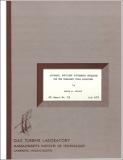| dc.contributor.author | Oliver, David A. (David Anthony), 1939- | en_US |
| dc.contributor.other | Massachusetts Institute of Technology. Gas Turbine Laboratory | en_US |
| dc.date.accessioned | 2016-09-27T19:59:01Z | |
| dc.date.available | 2016-09-27T19:59:01Z | |
| dc.date.issued | 1975 | en_US |
| dc.identifier.uri | http://hdl.handle.net/1721.1/104407 | |
| dc.description | July 1975 | en_US |
| dc.description | Includes bibliographical references (page 18) | en_US |
| dc.description.abstract | Introduction: A potentially powerful method for predicting and describing turbulent flow fields is that of utilizing a finite number of moments of the instantaneous Navier-Stokes equations. This sequence of moment equations is closed by theoretical modelling of the unknown correlations at the closure moment level. The use of an eddy viscosity which is "closed" in terms of the mean velocity gradient represents a familiar first order closure. A wide variety of turbulent flow fields are currently under investigation including boundary layers, shear layers, vortices, and wakes. Surveys of the general methods utilizing various closure models may be found in Reynolds 11], Mellor and Herring [2], and Donaldson [3]. The field equations for the turbulent flow which result from these moment equations are generally lengthy, simultaneous, non-linear partial differential equations of the initial value class. | en_US |
| dc.description.abstract | Very little attention has been given to the mathematical structure of these non-linear systems and to the development of accurate numerical methods for their solution. In many flows of interest, diffusion processes are always present in sufficient strength to give the equations a strong parabolic character. Most workers have therefore adopted fully implicit difference operators for the spatial derivatives and have then utilized iterative methods for solving the non-linear implicit equations. These fully implicit operators are apparently selected because of the unconditional stability which such operators provide for linear systems. In many highly non-equilibrium turbulent flows, the convective, production, and turbulent decay processes are stronger than the diffusive processes. In such situations the iterative techniques become slow in convergence or may not converge at all. | en_US |
| dc.description.abstract | In addition, fully implicit difference operators are only first order accurate and require a fine mesh spacing to properly resolve the structure of the flow. In the present work we offer a new class of second order accurate non-linear difference operators which are consistent, unconditionally stable (in the extended sense for the non-linear system discussed below), and which do not require iterative techniques for the solution of non-linear implicit equations. Hence these operators are highly efficient. We begin in Part II by discussing simple non-linear diffusion and convections equations and their possible difference operators. In Part III we examine a more complex non-linear diffusion equation which is representative of that which arises in mixing length closure models. It is here that the essential feature of the difference operator proposed in this work is presented. In Part IV we turn attention directly to the turbulent field equation models currently under investigation. | en_US |
| dc.description.abstract | Here we summarize these equations in a single archetypal form and we present the archetypal form of the difference operator for their solution. | en_US |
| dc.description.sponsorship | This research was supported by the NASA Lewis Research Center under Grant NGL 22-009-383 | en_US |
| dc.format.extent | 18 pages | en_US |
| dc.publisher | Cambridge, Mass. : Gas Turbine Laboratory, Massachusetts Institute of Technology, [1975] | en_US |
| dc.relation.ispartofseries | GTL report #121 | en_US |
| dc.subject.lcc | TJ778.M41 G24 no.121 | en_US |
| dc.subject.lcsh | Navier-Stokes equations | en_US |
| dc.subject.lcsh | Turbulence | en_US |
| dc.subject.lcsh | Fluid dynamics | en_US |
| dc.title | Accurate, efficient difference operators for the turbulent field equations | en_US |
| dc.type | Technical Report | en_US |
| dc.identifier.oclc | 02157323 | en_US |
